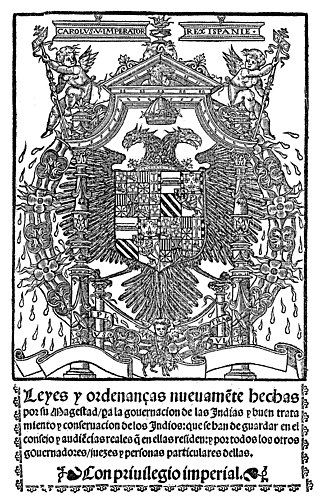The term Don abbreviated as D., is an honorific prefix primarily used in Spain and Hispanic America, and with different connotations also in Italy, Portugal and its former colonies, and formerly in the Philippines.

The encomienda was a Spanish labour system that rewarded conquerors with the labour of conquered non-Christian peoples. The labourers, in theory, were provided with benefits by the conquerors for whom they laboured, including military protection and education. The encomienda was first established in Spain following the Christian reconquest of Moorish territories, and it was applied on a much larger scale during the Spanish colonization of the Americas and the Spanish East Indies. Conquered peoples were considered vassals of the Spanish monarch. The Crown awarded an encomienda as a grant to a particular individual. In the conquest era of the early sixteenth century, the grants were considered to be a monopoly on the labour of particular groups of indigenous peoples, held in perpetuity by the grant holder, called the encomendero; starting from the New Laws of 1542, the encomienda ended upon the death of the encomendero, and was replaced by the repartimiento.

The New Laws, also known as the New Laws of the Indies for the Good Treatment and Preservation of the Indians were issued on November 20, 1542, by Charles V, Holy Roman Emperor and regard the Spanish colonization of the Americas. Following denunciations and calls for reform from individuals such as the Dominican friar Bartolomé de Las Casas, these laws were intended to prevent the exploitation and mistreatment of the indigenous peoples of the Americas by the encomenderos, by limiting their power and dominion over groups of natives.

Datu is a title which denotes the rulers of numerous Indigenous peoples throughout the Philippine archipelago. The title is still used today, though not as much as early Philippine history. It is a cognate of ratu in several other Austronesian languages.
The Battle of Reynogüelén took place between Spanish conquistadors and Mapuche soldiers, thought to have occurred near the confluence of the Ñuble and Itata Rivers, in Chile. This battle is an antecedent of the Arauco War.
The Laws of Burgos, promulgated on 27 December 1512 in Burgos, Crown of Castile (Spain), was the first codified set of laws governing the behavior of Spaniards in the Americas, particularly with regard to the Indigenous people of the Americas. They forbade the slavery of the indigenous people and endorsed their conversion to Catholicism. The laws were created following the conquest and Spanish colonization of the Americas in the West Indies, where the common law of Castile was not fully applicable. Friars and Spanish academics pressured King Ferdinand II of Aragon and his daughter, Queen regnant, Joanna of Castile, to pass the set of laws in order to protect the rights of the natives of the New World.

The principalía or noble class was the ruling and usually educated upper class in the pueblos of Spanish Philippines, comprising the gobernadorcillo, tenientes de justicia, and the cabezas de barangay who governed the districts. Also included in this class were former gobernadorcillos or municipal captains, and municipal lieutenants in good standing during their term of office.

The Laws of the Indies are the entire body of laws issued by the Spanish Crown for the American and the Asian possessions of its empire. They regulated social, political, religious, and economic life in these areas. The laws are composed of myriad decrees issued over the centuries and the important laws of the 16th century, which attempted to regulate the interactions between the settlers and natives, such as the Laws of Burgos (1512) and the New Laws (1542). Throughout the 400 years of Spanish presence in these parts of the world, the laws were compiled several times, most notably in 1680 under Charles II in the Recopilación de las Leyes de los Reynos de las Indias. This became considered the classic collection of the laws, although later laws superseded parts of it, and other compilations were issued.
A cabeza de barangay, also known as teniente del barrio, was the head of a barangay or barrio political unit in the Philippines during Spanish rule. The office was inherited from the Malayan aristocratic rank of datu after barangays had become tributaries of the Kingdom of the Spains and the Indies. Philip II of Spain decreed that the nobility in the Philippine islands should retain the honours and privileges they had before their conversion to Christianity and subjugation to Spanish rule.
Union, Progress and Democracy was a Spanish political party founded in September 2007 and dissolved in December 2020. It was a social-liberal party that rejected any form of nationalism, especially the separatist Basque and Catalan movements. The party was deeply pro-European and wanted the European Union to adopt a federal system without overlap between the European, national and regional governments. It also wanted to replace the State of Autonomies with a much more centralist, albeit still politically decentralized, unitary system as well as substituting a more proportional election law for the current one.
'Vecino' means either "neighbour" or resident in modern Spanish. Historically in the Spanish Empire it referred instead to a householder of considerable social position in a town or a city, and was similar to "freeman" or "freeholder."
Tasa de Gamboa or Rate of Gamboa was a money tax rate applied to the indigenous peoples in the Captaincy General of Chile by the Governor Martin Ruiz de Gamboa, in place of the tribute of personal service in the encomienda system, as desired by the kings of Spain. It replaced the Tasa de Santillán in an effort to end the abuses of the tribute of personal service.

Nobility is a social class found in many societies that have an aristocracy. It is normally ranked immediately below royalty. Nobility has often been an estate of the realm with many exclusive functions and characteristics. The characteristics associated with nobility may constitute substantial advantages over or relative to non-nobles or simply formal functions, and vary by country and by era. Membership in the nobility, including rights and responsibilities, is typically hereditary and patrilineal.

Enrique Múgica Herzog was a Spanish lawyer and politician.

The 1923 Spanish general election was held on Sunday, 29 April and on Sunday, 13 May 1923, to elect the 19th Cortes of the Kingdom of Spain in the Restoration period. All 409 seats in the Congress of Deputies were up for election, as well as 180 of 360 seats in the Senate.

The 1905 Spanish general election was held on Sunday, 10 September and on Sunday, 24 September 1905, to elect the 12th Cortes of the Kingdom of Spain in the Restoration period. All 404 seats in the Congress of Deputies were up for election, as well as 180 of 360 seats in the Senate.
The 1582 Cagayan battles were a series of clashes between the forces of the Spanish Philippines led by Captain Juan Pablo de Carrión and wokou headed by Tay Fusa. These battles, which took place in the vicinity of the Cagayan River, finally resulted in a Spanish victory.

Carl Henrik Langebaek Rueda is a Colombian anthropologist, archaeologist and historian. He has been contributing on the knowledge of archaeological evidences, especially the Herrera Period and the Muisca. Langebaek was vice-chancellor for academic affairs at Universidad de los Andes and speaks Spanish and English.
The caballería was a unit of land measurement in the Spanish viceroyalties in the Americas during the times of the Spanish Empire in the 16th through 19th centuries. It was equivalent to 78.58 hectares. The unit came from Spain, where it had already been in use.

Statues of Tlatoque Ahuitzotl and Itzcoatl are installed in Mexico City. They are collectively known as the Monumento a los Indios Verdes. The statues are verdigris due to the effects of weather. They are around 3 meters (9.8 ft) to 4 meters (13 ft) tall and their plinths have inscriptions in Nahuatl. The statues were created by Alejandro Casarín to represent Mexico at the 1889 Paris Exposition.











